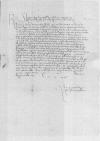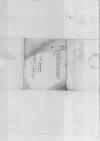Letter #2266
Sigismund I Jagiellon to Ioannes DANTISCUSCracow, 1540-01-04
| received 1540-01-09 Manuscript sources:
Prints:
| ||||||||||||||||||
Text & apparatus & commentaryPlain textText & commentaryText & apparatus
Reverendo in Christo Patri, domino
Reverende in Christo Pater sincere nobis dilecte.
Quae scribit ad nos Paternitas Vestra de serenissimo Daniae rege, ea iam ante ex illustris domini
Nominatim autem quibus de rebus scribit ad nos Paternitas Vestra, eas ibidem recenseri iussimus. Ad
Bene valeat Paternitas vestra.
Dat(ae) or Dat(um)⌈Dat(ae)Dat(ae) or Dat(um)⌉
Ad mandatum regiae maiestatis proprium


 AGAD, AZ, 2999, f. 176v
AGAD, AZ, 2999, f. 176v